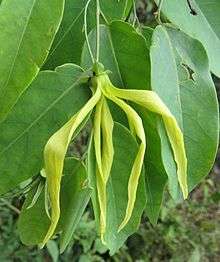Desmos chinensis
Desmos chinensis is a flowering plant of the custard-apple family, Annonaceae. The yellowish-green flowers are similar to the Ylang-ylang flowers, therefore this plant is sometimes known as dwarf ylang-ylang.[1] Their smell, however, is much less strong and is only felt in the morning. By midday it has mostly faded away.
| Desmos chinensis | |
|---|---|
 | |
| Desmos chinensis; detail of the flower | |
| Scientific classification | |
| Kingdom: | Plantae |
| Clade: | Tracheophytes |
| Clade: | Angiosperms |
| Clade: | Magnoliids |
| Order: | Magnoliales |
| Family: | Annonaceae |
| Genus: | Desmos |
| Species: | D. chinensis |
| Binomial name | |
| Desmos chinensis Lour. | |
| Synonyms | |
| |

Description and habitat
It is a vine or spreading shrub that may grow up to 4 m high if it finds an adequate support, otherwise it rarely grows taller than 150 cm.[2] Its pollen is shed as permanent tetrads.[3]
Desmos chinensis is found throughout Southeast Asia from Nepal to the Philippines. It grows at the edge of forests in flat areas up to heights of 600 m. It may grow as a ruderal plant on the sides of roads, rural causeways and other disturbed terrain. It thrives in slightly shady places.
This tree is commonly used within the Bangkok urban landscape. Desmos chinensis is used to create shade along various sidewalks and bus stops. It is widely utilised in city settings, due to its dense leaf growth which provides cool shade, a relatively thin trunk and a root system that doesn't break sidewalk pavement.
Names
- Malay: Akar pisang-pisang, kenanga hutan, akar darah.
- Tagalog: Ilang-ilang gubat.
- Thai: Saaiyut สายหยุด (Central & Peninsular), Kluai khruea (Saraburi), khruea khao klaep (Loei).
- Vietnamese: hoa giẻ thơm, nối côi.
References
- Desmos chinensis; Dwarf Ylang Ylang Shrub
- Desmos chinensis
- Walker JW (1971) Pollen Morphology, Phytogeography, and Phylogeny of the Annonaceae. Contributions from the Gray Herbarium of Harvard University, 202: 1-130.
External links
| Wikimedia Commons has media related to Desmos chinensis. |